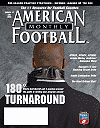AMERICAN FOOTBALL MONTHLY THE #1 RESOURCE FOR FOOTBALL COACHES
Article CategoriesAFM Magazine
|
Impact Stats: The Most Critical Statistic in Footballby: AFM Editorial Staff© More from this issue Obviously the most important statistics in a football game are points scored and allowed – that will determine the winners and losers. But what comes next? What statistic plays the biggest role in determining a game’s outcome? We asked nine successful coaches that question. And eight of them answered that it’s turnover margin. One said average starting field position. Here are the coaches’ explanations. “Obviously every possession is very valuable,” said Mike Whelan, head coach of Division III Williams College in Williamstown, MA. “Turnovers will affect a lot of things. They will affect your time of possession and starting field position. They really dictate a lot of other statistics. And there’s a psychological component. Football is a game of momentum. Anytime there’s a turnover, one side is excited, and the other is dejected. It can certainly change the outcome of a game.” Whelan put the issues in stark terms: “You can’t score if you don’t have the ball. The more opportunities you give an opponent, the more probability that they will score.” K.C. Keeler, the head coach at Division I-AA powerhouse Delaware, said he looked back at 15 years of Blue Hen football, and the team won 75-80 percent of games in which they had a turnover margin of plus one. “I told the kids that I’ll be in the College Football Hall of Fame if we win 75 percent of our games.” Attention to turnovers represents a big part of Delaware practices, Keeler said. “In practice every day we talk with the defense about creating turnovers and with the offense and special teams about keeping two hands on the ball in traffic and with the quarterback about throwing the ball away if need be. We spend so much time on strips and recovering fumbles and tipping balls in practice,” he said. “On offense we have wide receivers and running backs doing a drill everyday with a rope on the ball trying to take it out of their hands. We actually do drills with our quarterbacks to throw the ball away and not get turnovers.” Keeler creates four key goals for his players. First, win the game. Second, win the fourth quarter. Third, win the turnover battle. Fourth, create big plays of 20 yards plus. Like Whelan, he stressed the effect of turnovers on momentum. “You’re asking the opponent to overcome adversity you don’t have to overcome. It’s an emotional boost.” A large part of the impact of turnovers is psychological, coaches agreed. “Just the mojo that a turnover brings with it is huge, “ said Chris Petersen, head coach at Boise State University. Bob Berezowitz, head coach of the University of Wisconsin-Whitewater, runner-up in last year’s Division III playoffs, likes the focus on a team statistic rather than an individual one. “If you’re going to win as a team, you want something that is measurable for both sides of the ball,” he said. “Offensive and defensive statistics don’t really mean a lot to me. If we’re winning the turnover battle, we’re not fumbling the ball and throwing interceptions, yet on defense, we’re creating turnovers. That creates opportunities to score.” Kevin Donley, head coach at University of Saint Francis in Fort Wayne, IN, NAIA runner-up last year, pointed out the importance of each possession. “If you turn it back over without being productive, you don’t have a chance to at least punt to give them more distance to score. You’re obviously at a disadvantage.” Turnovers can overwhelm other statistics, notes Chris Hatcher, head coach of Division II Valdosta State . “You could actually lead the game in passing and rushing yards and have more time of possession. But if your drives end in turnovers, you won’t get many points. If you’re playing a good ball team, that ends up haunting you at the end of the game.” Tony Severino, head coach at Rockhurst High School in Kansas City noted that turnovers can snowball. “If you commit one that turns into a score the kids are pressing, trying to make things happen. So all of a sudden more bad things happen.” E.J. Mills, head coach of Division III Amherst College, pointed out that there is such a thing as a good turnover. “If you’re chucking the ball 50 yards out of your end zone for an interception, that’s better than trying to punt out of the end zone.” But he said that’s just an exception to the rule. “We say that if you’re winning the turnover battle, you’re going to win the game more often than not.” As for the contrarian, Chuck Broyles, head coach of Pittsburg State, chose average starting field position as the most significant stat. “A lot of things go into that,” he said. “Do you play great defense? Do you get a lot of takeaways? Do you have a great punter to pin the other team? Is your offensive philosophy to run a lot and not take chances? Through the years, it’s been hard for us not to score if we get the ball close to midfield.” |
|
| HOME |
MAGAZINE |
SUBSCRIBE | ONLINE COLUMNISTS | COACHING VIDEOS |
Copyright 2024, AmericanFootballMonthly.com
All Rights Reserved




